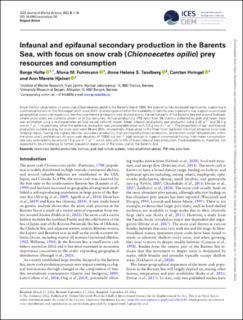| dc.contributor.author | Holte, Børge | |
| dc.contributor.author | Fuhrmann, Mona Maria | |
| dc.contributor.author | Tandberg, Anne Helene S. | |
| dc.contributor.author | Hvingel, Carsten | |
| dc.contributor.author | Hjelset, Ann Merete | |
| dc.date.accessioned | 2022-11-14T13:50:58Z | |
| dc.date.available | 2022-11-14T13:50:58Z | |
| dc.date.created | 2022-11-08T18:46:27Z | |
| dc.date.issued | 2022 | |
| dc.identifier.citation | ICES Journal of Marine Science. 2022, . | en_US |
| dc.identifier.issn | 1054-3139 | |
| dc.identifier.uri | https://hdl.handle.net/11250/3031739 | |
| dc.description.abstract | Since the first observation of snow crab (Chionoecetes opilio) in the Barents Sea in 1996, the population has increased significantly, supporting a commercial fishery on the Norwegian shelf since 2012. To investigate whether the availability of benthic prey organisms may support a continued geographical snow crab expansion, benthic invertebrate production was studied across the central parts of the Barents Sea and around Svalbard, where snow crabs are currently absent or at low densities. Annual productivity (P/B ratio) from 66 stations collected by grab and beam trawl was estimated using a multiparameter artificial neural network model. Mean infaunal productivity and production were 0.43 yr−1 and 38.4 g ww m−2 yr−1, respectively, while the epifaunal production was considerably lower with 2.5 g ww m−2 yr−1. The proportions of epi- and infaunal production suitable as prey for snow crab were 98 and 96%, respectively. Areas close to the Polar Front represent the most attractive snow crab foraging region, having the highest benthic secondary production, high estimated primary production, and bottom water temperatures within the snow crab’s preferences. At snow crab densities of 12800 ind. km−2, high enough to support commercial fishing, their mean consumption rate was estimated to be around 1.5 g ww m−2 yr−1, which amounts to 4% of mean infaunal prey production. Food availability is, therefore, not expected to be a hindrance to further population expansion of the snow crab in the Barents Sea. | en_US |
| dc.language.iso | eng | en_US |
| dc.title | Infaunal and epifaunal secondary production in the BarentsSea, with focus on snow crab (Chionoecetes opilio)preyresources and consumption | en_US |
| dc.title.alternative | Infaunal and epifaunal secondary production in the BarentsSea, with focus on snow crab (Chionoecetes opilio)preyresources and consumption | en_US |
| dc.type | Peer reviewed | en_US |
| dc.type | Journal article | en_US |
| dc.description.version | publishedVersion | en_US |
| dc.source.pagenumber | 16 | en_US |
| dc.source.journal | ICES Journal of Marine Science | en_US |
| dc.identifier.doi | 10.1093/icesjms/fsac192 | |
| dc.identifier.cristin | 2070839 | |
| dc.relation.project | Havforskningsinstituttet: 14862 | en_US |
| dc.relation.project | Egen institusjon: Mareano prosjektet | en_US |
| cristin.ispublished | true | |
| cristin.fulltext | original | |
| cristin.qualitycode | 2 | |
